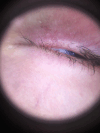Ciliary Madarosis Secondary to Intra-Arterial Chemotherapy for Retinoblastoma Treatment
- PMID: 38835713
- PMCID: PMC11147517
- DOI: 10.1159/000535826
Ciliary Madarosis Secondary to Intra-Arterial Chemotherapy for Retinoblastoma Treatment
Abstract
Background: Retinoblastoma is the most common intraocular tumor in the pediatric population. Its main therapeutic objectives are to avoid fatal outcomes and preserve vision as much as possible. Intra-arterial chemotherapy (IAC) improves drug delivery and reduces possible systemic adverse effects. This modality allows direct administration of chemotherapeutic agents to intraocular malignancies via the ophthalmic artery (OA), proving to be a feasible and effective method for globe salvage. Most side effects of IAC are local, including eyelash loss of the nasal portion of the eyelid.
Summary: We performed a comprehensive review to analyze data regarding ciliary madarosis in patients diagnosed with retinoblastoma treated with IAC. We describe 9 studies with a total of 637 eyes with retinoblastoma that underwent IAC, of which 45 cases presented madarosis. In chemotherapy-induced alopecia, there is hair shaft thinning and breakage. On trichoscopy, the remaining end of the fractured hair will be observed as black dots. Differential diagnoses must include alopecia areata and trichotillomania.
Key messages: Ciliary madarosis secondary to IAC, although transitional, may cause discomfort in patients and family members. Physical examination, as well as a trichoscopic evaluation of the affected area, can help in reaching a prompt diagnosis and prognosis for this particular alopecia.
Keywords: Alopecia; Chemotherapy; Ciliary; Intra-arterial chemotherapy; Madarosis; Retinoblastoma.
© 2024 S. Karger AG, Basel.
Conflict of interest statement
The authors have no conflicts of interest to declare.
Figures


Similar articles
-
Intra-arterial chemotherapy in refractory and advanced intraocular retinoblastoma.Indian J Ophthalmol. 2023 Feb;71(2):436-443. doi: 10.4103/ijo.IJO_1388_22. Indian J Ophthalmol. 2023. PMID: 36727336 Free PMC article.
-
Rescue intra-arterial chemotherapy following retinoblastoma recurrence after initial intra-arterial chemotherapy.J Fr Ophtalmol. 2015 Jun;38(6):542-9. doi: 10.1016/j.jfo.2015.03.004. Epub 2015 May 14. J Fr Ophtalmol. 2015. PMID: 25982423
-
Intra-arterial chemotherapy as primary or secondary treatment for infants diagnosed with advanced retinoblastoma before 3 months of age.BMC Cancer. 2019 Jul 15;19(1):693. doi: 10.1186/s12885-019-5844-5. BMC Cancer. 2019. PMID: 31307410 Free PMC article.
-
An updated review of intra-arterial chemotherapy for retinoblastoma.Radiologia (Engl Ed). 2025 Mar-Apr;67(2):162-175. doi: 10.1016/j.rxeng.2025.02.001. Epub 2025 Mar 1. Radiologia (Engl Ed). 2025. PMID: 40187809 Review.
-
Intra-arterial chemotherapy in retinoblastoma - A paradigm change.Indian J Ophthalmol. 2019 Jun;67(6):740-754. doi: 10.4103/ijo.IJO_866_19. Indian J Ophthalmol. 2019. PMID: 31124482 Free PMC article. Review.
References
-
- Abramson DH. Chemosurgery for retinoblastoma: what we know after 5 years. Arch Ophthalmol. 2011;129(11):1492–4. - PubMed
-
- Yamane T, Kaneko A, Mohri M. The technique of ophthalmic arterial infusion therapy for patients with intraocular retinoblastoma. Int J Clin Oncol. 2004;9(2):69–73. - PubMed
-
- Abramson DH, Dunkel IJ, Brodie SE, Kim JW, Gobin YP. A phase I/II study of direct intra-arterial (ophthalmic artery) chemotherapy with melphalan for intraocular retinoblastoma initial results. Ophthalmology. 2008;115(8):1398–404.e1. - PubMed
-
- Abramson DH, Dunkel IJ, Brodie SE, Marr B, Gobin YP. Superselective ophthalmic artery chemotherapy as primary treatment for retinoblastoma (chemosurgery). Ophthalmology. 2010;117(8):1623–9. - PubMed
Publication types
LinkOut - more resources
Full Text Sources

